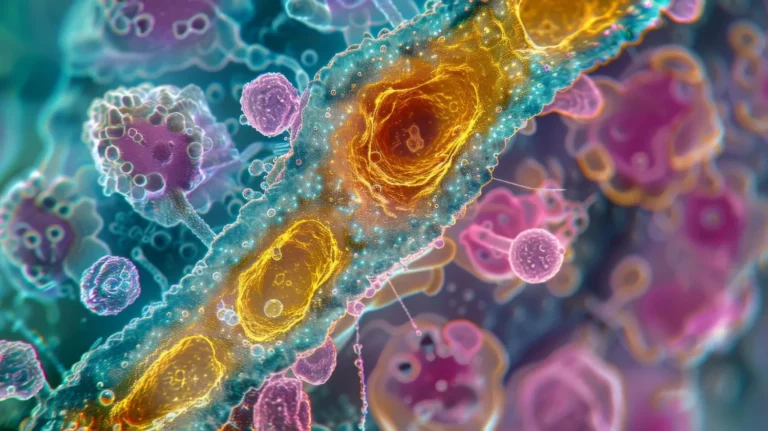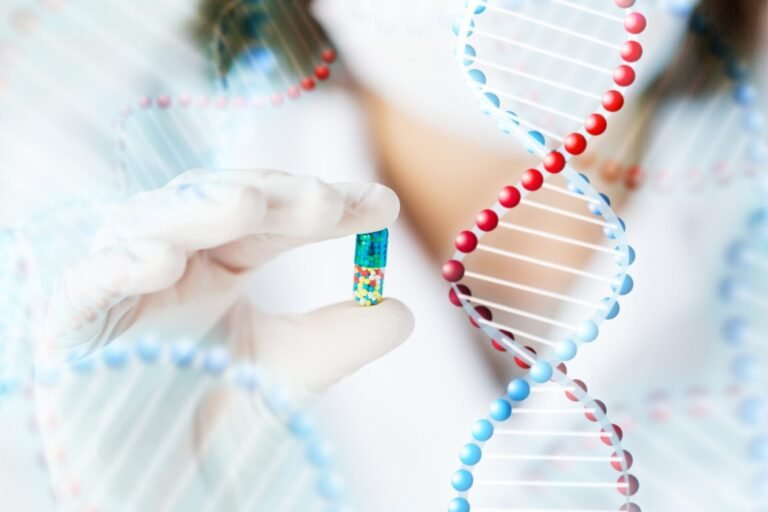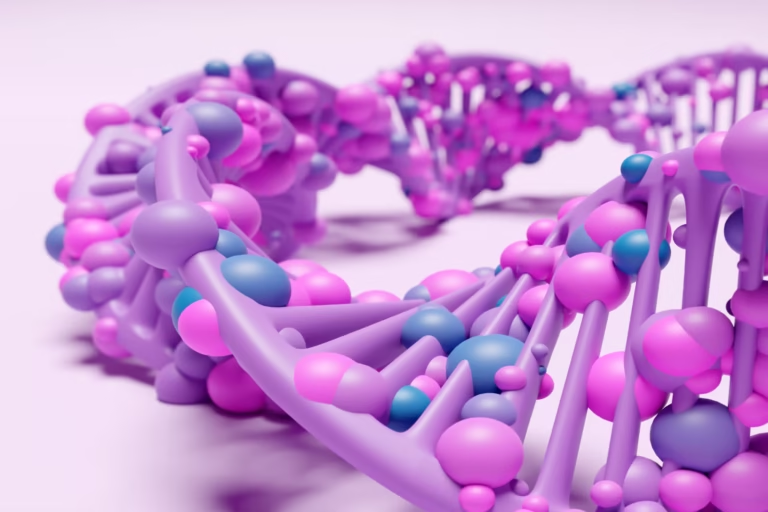Understanding Cytochrome’s Role in Cells
Have you ever wondered how cells generate energy and maintain their function? One crucial player in these processes is cytochrome c. But what exactly is the role of cytochrome c in electron transfer, and how does it contribute to the overall functions of cells?

Key Takeaways:
- Cytochrome c is an essential protein involved in mitochondrial electron transport, oxidative phosphorylation, apoptosis, and reactive oxygen species scavenging.
- It plays a vital role in ATP production and is crucial for maintaining cellular homeostasis.
- Cytochrome c has a well-defined structure with a heme group that enables electron transfer in the mitochondrial electron transport chain.
- There are different types of cytochrome proteins, including cytochrome p450, that serve various functions in cells.
- Understanding cytochrome c’s role can shed light on cellular metabolism and energy production.
Functions of Cytochrome c
Cytochrome c plays several important functions in cells. It is involved in oxidative phosphorylation, the process by which ATP is produced in the mitochondria. Cytochrome c participates in electron transfer as part of the mitochondrial electron transport chain, allowing for the production of ATP.
Additionally, cytochrome c plays a crucial role in apoptosis, the programmed cell death process. It can trigger the assembly of the apoptosome, a protein complex that activates caspases, leading to cell death.
Furthermore, cytochrome c is involved in the oxidation of cardiolipin, a phospholipid in the inner mitochondrial membrane. This oxidation can cause damage to the membrane and disrupt cellular function.
Cytochrome c also serves as a scavenger of reactive oxygen species (ROS), protecting cells from oxidative damage. By neutralizing ROS, cytochrome c helps maintain cellular homeostasis and prevents oxidative stress-related diseases.
“The functions of cytochrome c are vital for various cellular processes, including energy production, cell death regulation, and maintenance of mitochondrial membrane integrity.”
Understanding the functions of cytochrome c provides valuable insights into the intricate mechanisms that govern cellular metabolism and homeostasis.
The image above visually represents the important role of cytochrome c in maintaining mitochondrial membrane potential, a crucial factor in cellular processes.
Structure of Cytochrome c
Cytochrome c is a small, water-soluble protein with a molecular weight of about 12,000. Its structure is well-defined and highly conserved across different organisms. The protein chain of cytochrome c is covalently linked to the heme group through thioether bonds with specific amino acid residues.
The heme group in cytochrome c plays a crucial role in its function. It consists of an iron ion coordinated by a porphyrin ring structure. The heme iron is in a hexacoordinate configuration, with histidine and methionine serving as iron ligands. This coordination allows for efficient electron transfer in the mitochondrial electron transport chain.
The heme group is situated in a hydrophobic environment within the protein, with only a small portion of its surface exposed to the solvent. This hydrophobic environment helps to stabilize the heme group and protect it from interacting with water molecules.
The exposed portion of the heme group is responsible for electron transfer in the mitochondrial electron transport chain. It serves as the site where electrons are transferred between cytochrome c and other components of the electron transport chain, such as cytochrome c oxidase.
The structure of cytochrome c has been determined in various species, and its conservation across different organisms highlights its importance in cellular processes.
Role of Cytochrome c in Electron Transfer
Cytochrome c plays a crucial role in electron transfer within the mitochondria. As a single electron carrier, it facilitates the transfer of electrons in the final step of the electron transport chain. Specifically, cytochrome c transfers electrons from the bc1 complex to cytochrome c oxidase (CcO), which is vital for ATP production in the mitochondria.
During this process, cytochrome c-1 acts as the electron donor, transferring electrons to cytochrome c. Subsequently, cytochrome c transfers these electrons to CcO, allowing for the final step of electron transfer to occur.
The binding of cytochrome c to the integral membrane proteins of the electron transport chain is facilitated by a cluster of positively charged lysine residues on the surface of the protein. This interaction ensures efficient electron transfer and maintains the proper functioning of the electron transport chain.
Types of Cytochrome c
In understanding the remarkable role of cytochrome c in cellular respiration and energy production, it is important to explore the various types of this evolutionarily conserved nuclear-encoded mitochondrial protein. Cytochrome c is not limited to specific species; it can be found in a wide range of organisms, from mammals and birds to reptiles and fish. Despite some minor variations in the amino acid sequence, the overall structure and function of cytochrome c remain highly conserved across different species.
This evolutionary conservation underscores the critical importance of cytochrome c in cellular respiration and energy production. Its ability to efficiently participate in electron transfer, coupled with its role in oxidative phosphorylation, establishes cytochrome c as a key player in the intricate mechanisms governing cellular metabolism and homeostasis.
The highly conserved nature of cytochrome c also suggests its fundamental significance in the maintenance of essential cellular processes. Whether it is facilitating ATP production or participating in redox reactions, cytochrome c is an irreplaceable component of the mitochondrial electron transport chain.
Through its remarkable evolutionary conservation as well as its status as a nuclear-encoded mitochondrial protein, cytochrome c continues to contribute significantly to our understanding of cellular respiration and its crucial role in energy production.
Key Points:
- Cytochrome c is an evolutionarily conserved nuclear-encoded mitochondrial protein.
- It is found in a wide range of organisms, from mammals and birds to reptiles and fish.
- The overall structure and function of cytochrome c are highly conserved across different species.
- Cytochrome c plays a vital role in cellular respiration and energy production.
Heme Group in Cytochrome c
The heme group in cytochrome c plays a critical role in its function within the cell. Comprised of an iron ion coordinated by a porphyrin ring structure, the heme group is essential for electron transfer in the mitochondrial electron transport chain.
In the specific case of cytochrome c, the heme iron is in a hexacoordinate configuration, with two amino acid ligands: histidine and methionine. These ligands provide stability and assist in the efficient transfer of electrons.
The heme group is situated in a hydrophobic environment within the protein, protecting it from premature oxidation or reduction reactions. This hydrophobic environment allows for the creation of a high redox potential in cytochrome c, facilitating its role in electron transfer.
Overall, the heme group in cytochrome c, with its iron ion and ligands, serves as the critical center for electron transfer in the mitochondria, ensuring the efficient production of ATP.
| Ligands | Function |
|---|---|
| Histidine | Stabilizes the heme group and facilitates electron transfer |
| Methionine | Provides additional stability to the heme group |
Cytochrome p450 and Other Types of Cytochrome
Cytochrome c is just one member of a larger family of cytochrome proteins. Another well-known type is cytochrome p450, which is involved in drug metabolism and various biochemical reactions. Cytochrome p450 enzymes play a crucial role in the oxidation of organic substances, including drugs and toxins, in the liver and other tissues. They are responsible for the detoxification and elimination of many foreign compounds from the body.
Aside from cytochrome p450, there are other types of cytochrome proteins that also play important roles in cellular processes. These include cytochrome b and cytochrome c1. Cytochrome b is a component of the bc1 complex, which functions in mitochondrial electron transport and ATP production. Cytochrome c1 is another integral component of the electron transport chain and participates in the transfer of electrons from cytochrome b to cytochrome c.
These various types of cytochrome proteins are found in different cellular compartments and carry out specific functions. They work together in the intricate network of redox reactions within cells, allowing for efficient energy production and other essential biochemical processes.
Role of Cytochrome c in Redox Reactions
Cytochrome c, a key protein in cellular respiration, plays a crucial role in redox reactions within cells. These reactions are involved in both life-sustaining functions and cell death processes. Let’s explore the diverse roles of cytochrome c in these processes.
Oxidative Phosphorylation and ATP Production
Cytochrome c is directly involved in oxidative phosphorylation, a vital process that generates ATP (adenosine triphosphate) in the mitochondria. By participating in electron transfer as part of the mitochondrial electron transport chain, cytochrome c facilitates the production of ATP, the energy currency of the cell.
Apoptosis Activation
In addition to its role in energy production, cytochrome c also plays a pivotal role in apoptosis, the programmed cell death process. When triggered by specific cellular cues, cytochrome c initiates apoptosis by triggering the assembly of the apoptosome complex. This complex activates caspases, leading to the controlled destruction of cells in a tightly regulated manner.
“Cytochrome c acts as a molecular switch, shifting from an energy-producing role to a cell death-initiating role in apoptosis activation.”
Reactive Oxygen Species Regulation
Under normal physiological conditions, cytochrome c can also scavenge reactive oxygen species (ROS). These ROS are harmful byproducts of cellular metabolism that can cause oxidative damage to proteins, lipids, and DNA. By neutralizing ROS, cytochrome c helps protect cells from oxidative damage and maintains cellular homeostasis.
However, under certain circumstances, cytochrome c can also generate reactive oxygen species, contributing to oxidative stress. This process, combined with the oxidation of cardiolipin, a phospholipid in the inner mitochondrial membrane, can lead to mitochondrial membrane damage and cell death.
Through its involvement in redox reactions, cytochrome c holds a dual role in cellular processes. It serves as a crucial player in energy production and apoptosis, while also participating in the regulation of reactive oxygen species. The intricate balance of cytochrome c’s functions highlights its importance in maintaining cellular health and proper functioning.

| Role of Cytochrome c in Redox Reactions | Keywords |
|---|---|
| Oxidative Phosphorylation and ATP Production | cytochrome c, oxidative phosphorylation, ATP production, electron transfer, mitochondria |
| Apoptosis Activation | cytochrome c, apoptosis, apoptosome complex, cell death, caspases |
| Reactive Oxygen Species Regulation | cytochrome c, reactive oxygen species, ROS, oxidative damage, homeostasis |
Conclusion
Cytochrome c is a critical protein that plays a pivotal role in cellular respiration and energy production. Through its involvement in electron transfer, apoptosis, and regulation of reactive oxygen species, cytochrome c contributes to the intricate mechanisms of cellular metabolism and homeostasis.
Extensive studies have provided a deep understanding of the structure and function of cytochrome c, revealing its high conservation across different species. This conservation emphasizes the importance of cytochrome c in maintaining cellular function and highlights its significance in the evolution of life on Earth.
By comprehending the multiple functions of cytochrome c and its crucial role in cellular processes, researchers can unlock further insights into the intricate workings of cells. Studying this critical protein allows us to gain a better understanding of the fundamental mechanisms that govern energy production, cell survival, and the delicate balance of cellular activities.
FAQ
What are the functions of cytochrome c?
Cytochrome c plays several important functions in cells. It is involved in oxidative phosphorylation, electron transfer in the mitochondrial electron transport chain, apoptosis, and the scavenging of reactive oxygen species.
How does cytochrome c participate in oxidative phosphorylation?
Cytochrome c participates in oxidative phosphorylation by transferring electrons as part of the mitochondrial electron transport chain, allowing for the production of ATP.
What role does cytochrome c play in apoptosis?
Cytochrome c triggers the assembly of the apoptosome, a protein complex that activates caspases, leading to cell death.
What is the role of cytochrome c in the oxidation of cardiolipin?
Cytochrome c is involved in the oxidation of cardiolipin, a phospholipid in the inner mitochondrial membrane. This oxidation can cause damage to the membrane and disrupt cellular function.
How is the structure of cytochrome c organized?
Cytochrome c is a small, water-soluble protein with a heme group covalently linked to the protein chain. The heme iron is in a hexacoordinate configuration and is responsible for electron transfer in the mitochondrial electron transport chain.
What is the role of cytochrome c in electron transfer?
Cytochrome c functions as a single electron carrier, transferring electrons from the bc1 complex to cytochrome c oxidase (CcO) in the final step of the electron transport chain.
Are there different types of cytochrome c?
Yes, there are various types of cytochrome proteins, including cytochrome p450, cytochromes b and c1, which have specific functions and are found in different cellular compartments.
How does the heme group in cytochrome c contribute to its function?
The heme group in cytochrome c consists of an iron ion coordinated by a porphyrin ring structure. It has a high redox potential that allows for efficient electron transfer in the mitochondrial electron transport chain.
What is the role of cytochrome c in redox reactions?
Cytochrome c is involved in redox reactions and can participate in both life-sustaining functions and cell death processes. It can scavenge reactive oxygen species under healthy conditions but can also produce reactive oxygen species under certain circumstances, leading to oxidative damage and apoptosis.






